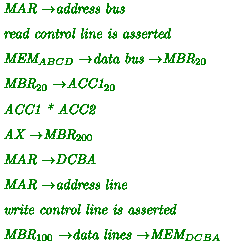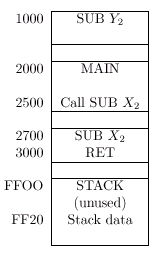| (a) |
Define each of the following terms: (i)operand part of a CPU instruction used to hold values or specify addresses (1) (ii)opcode part of a CPU instruction that specifies the particular operation to be performed (1) (iii)register internal memory of CPU,very fast (or used to hold temporary results)(1) (iv)interrupt an asynchronous event that suspends a CPU from its ordinary operation and jumps to a pre-programmed routine called a handler (1) (v)immediate addressing instruction where the operand specifies the actual data value to be used (not the address)(1)
|
[5] | |
| (b) |
For each of the following definitions,give the name of the network topology being described. (i)A common carrier channel over which data packets can be transmitted,either to a specific destination or in a broadcast mode. bus network (1) (ii)Nodes maybe fullyconnected,with everynode connected to everyother node,or partiallyconnected. mesh network (1) (iii)All nodes are connected to a central controller which supervises the operation of the entire network. star network (1)
|
[3] | |
| (c) |
Show the steps of the execute cycle for the following instruction,which uses a three-address format (source,source,destination).Assume that initially,R1 contains the value 10,ABCD contains 20,and DCBA contains 30. MUL R1 ,[ABCD ],[DCBA ]
Up to (2)for the fetch from register R1 into the accumulator.The details of such fetches (done here in one step)are not in the study guide,so other approaches should be given credit. Up to (3)for the details of the fetch of ABCD,(1) for the multiplication,and up to (2)for putting the data back to memory at DCBA .
|
[8] | |
| (d) |
Suppose that the general-purpose registers shown below have the values indicated,and that the steps of the program on the left are executed in sequence.Show all working,and with a diagram show how the values change in these general-purpose registers.
(1)for each step.If only one or two steps are orrect,but the .nal state is shown correctly, award (2)or (3)respectively.
|
[4] | |
| (e) |
The diagram below shows an example of a program loaded into memory,including some subroutines.Suppose that execution begins at MAIN.What will be the first subroutine call?How will the stack pointer and program counter change during the subroutine call?
Award up to four marks for these observations: When the PC reaches 2500,SUB X 2 will be called (1). The PC will be incremented to 2501 (1),and the SP will be decremented to FF1E (1), this PC value will be stored at that SP address (1),and the PC will then be loaded with 2700, the starting address (SA) of the subroutine (1).
|
[4] | |
| (f) |
Describe three characteristics of a local area network (LAN) that distinguish it from other networks. Any three from the following,or other valid points,one mark each: •nodes are located in a relatively limited geographical area •owned by a single organization •usually decentralized control •high data rate (Ethernet —10 Mbps) •low error rate •inexpensive transmission medium (e.g.coaxial)
|
[3] | |
| (g) |
What is the lowest level of the OSI model?What features are covered bythis level? Physical (1):deals with the mechanical,electrical,functional and procedural characteristics (1)to achieve access to the physical medium (1). |
[3] |




